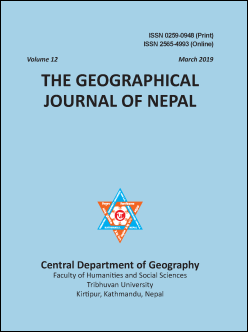Commercial vegetable farming: Constraints and opportunities of farmers in Kirtipur, Nepal
DOI:
https://doi.org/10.3126/gjn.v12i1.23418Keywords:
vegetable farming, marketing, leasehold farmland, KirtipurAbstract
Vegetable farming is one of the alternative sources of earning livelihood and becoming important agricultural practices for income generation and employment opportunities. This paper aims to analyze the constraints and opportunities of vegetable farmers in Kirtipur. Altogether 80 farm household survey were conducted in four major areas of Kirtipur. A total of 20 key informant interviews (KII) were also conducted to understand the perception of farm households on commercial vegetable farming. The result shows that around 94% of the total sampled farm households have leasehold farmland that has spread to different settlements of Kirtipur Municipality. Out of total leasehold farmers, 69% have written agreement with the landowner. The result also shows that the farmers cultivate vegetables in an average area of 5.67 ropani (2884.49m2). Tomato (Solanum lycopersicum) and mushroom (Agaricus bisporus) are the primary vegetable products, whereas cauliflower (Brassica oleracea) and other green leafy vegetables are mostly cultivated as secondary vegetable products. Dug wells are the major sources of irrigation on vegetable farmland. Out of the total sampled farm households, about 42% of farmers are associated with farmers group and 37% have basic training on vegetable farming. Majority of farmers have savings from vegetable production and marketing. Despite few constraints like price fluctuation (81%) and high middleman margins (71%), vegetable farming in Kirtipur has many opportunities particularly being a major source income and livelihood (93%), self-employment generation (87%) and growing market demand (83%). The opportunities in commercial vegetable farming have continuously attracted the farmers in Kirtipur; however, the existing constraints has deprived farmers from their expected returns. Therefore, this paper recommends to portray possible options to promote opportunities and overcome the existing constraints to retain commercial vegetable farming as a sustainable source for farm households in Kirtipur.
Downloads
Downloads
Published
How to Cite
Issue
Section
License
© Authors




